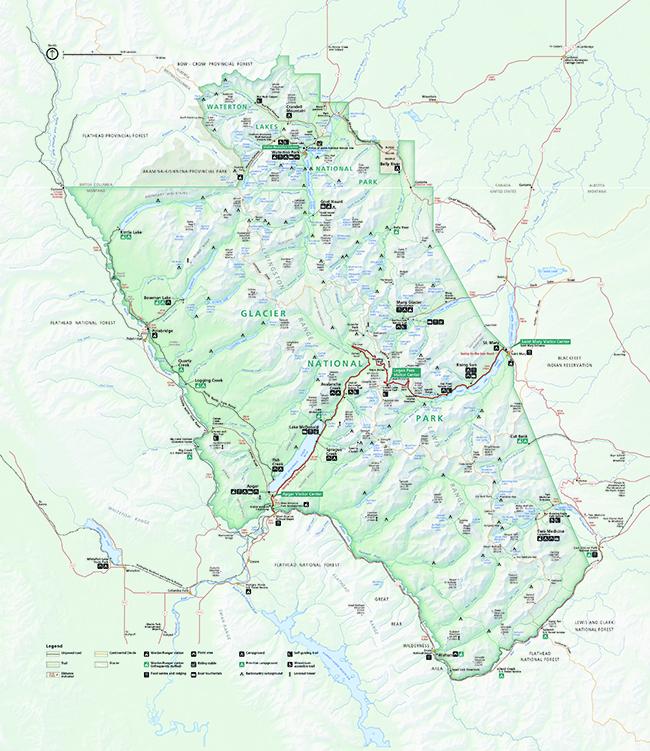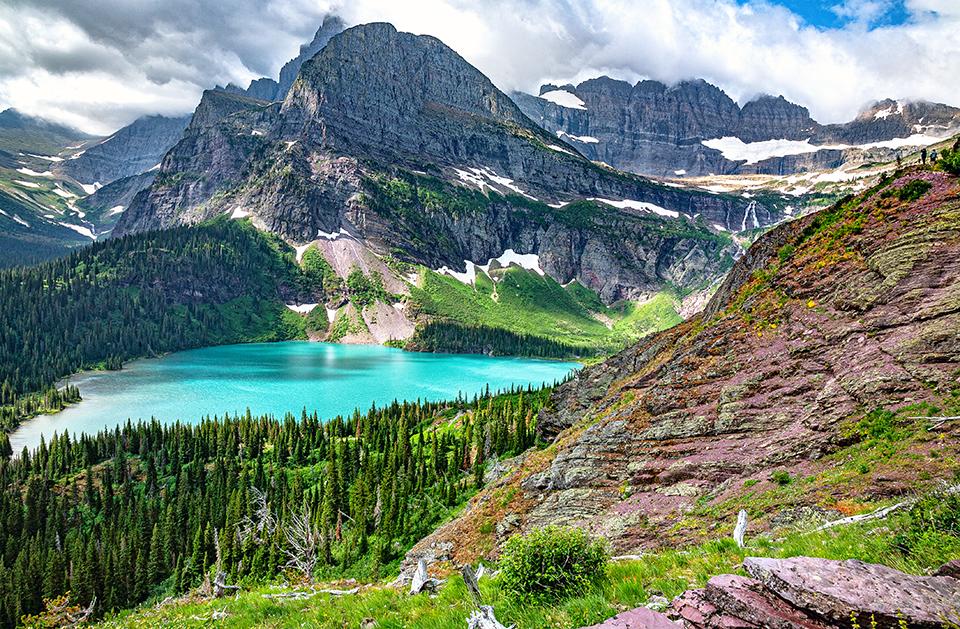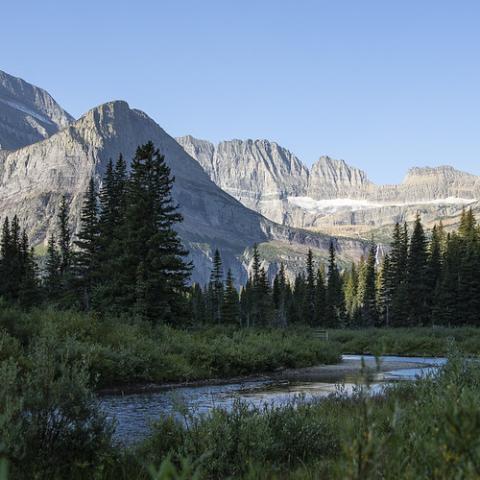
A slice of paradise, Glacier National Park / Rebecca Latson
There is a difference between a park that is a favorite, and a park that is a part of your heart. The park that’s captured my heart is Glacier National Park, in Montana. Perhaps because I was born only 24 miles from its western entrance. Perhaps because I’ve visited it more than once over my lifetime, so I have quite a few memories. Perhaps it’s a number of other things I can’t quite put into words. If you are thinking of visiting this park of my heart (and it may become a park of your heart, too), then this Traveler’s Checklist can help you make the most of your explorations.
The “Crown Jewel of The Continent,” nestled within the mountains of northwest Montana, is a paradise of glacier-fed turquoise waters, forests, wildflower-carpeted alpine meadows, and rugged mountains. Not only is it a hiker’s dream, but hikers and non-hikers alike can experience “wilderness and solitude,”, drive 50 miles along one of America’s most scenic highways, and explore the park’s past while visiting - perhaps even spending one or more nights - within its historic lodges.

Map of Glacier National Park / National Park Service
The western entrance to the park is 25 miles from Glacier Park International Airport, just outside of Kalispell. The eastern entrance is about two-and-one-half hours’ drive time from Great Falls International Airport. I’ve traveled to the park from both airports, and the drive either way is pure scenic Montana.
- As you review your packing list, remember to stow a little warm clothing and rain gear to go with your shorts and t-shirts. Even during the summer, mountain weather can change quickly during a single day, and you don’t want to be caught with no protection against rain or snow on the trail. While you are at it, pack some sunscreen. The higher elevations means you’ll sunburn sooner.
- Definitely do not forget to pack sturdy hiking boots. Flip flops and sneakers with slim-to-no-tread are a recipe for a turned ankle.
- Make sure you have bear spray. While a quick check of airlines tells me bear spray is prohibited in both carry-on and checked luggage, you can purchase or rent bear spray (yes, you can rent it, then return the unused portion) upon your arrival in Montana.
- Glacier is an extremely popular park, with heavy visitation during the summer. The park attracted 3.05 million people in 2019. That means if you wish to stay in any of the park’s brick-and-mortar lodges, you should try to reserve your room six months to a year ahead of your trip. Although pricey, if you have the opportunity to spend even one night in one of Glacier’s historic lodges, it’s definitely a treat to do so, as long as you understand these are rustic rooms and you may not have all the amenities you might expect from, say, the Ritz-Carlton. If you can’t lodge within the park, there are quite a few options outside the park, in the surrounding communities. I loved my stay in one of the Glacier Cabins at St. Mary Lodge & Resort, right outside the St. Mary Entrance, but it was a definite splurge and you can probably find less-expensive lodging near both the east and west park entrances. Again, though, you’ll need to reserve far ahead of your trip.
- There are 13 campgrounds inside the park. You can make reservations for some campgrounds, and others are on a first-come, first-served basis. Note: due to limited staff and the ongoing pandemic, the St. Mary and Rising Sun campgrounds are both closed for the 2021 season. It’s a good idea to periodically check the status of the park’s campgrounds to see whether or not they are open, what the fees are, available amenities, RV size limitations, and historic fill times. If you can’t find anything within the park, check the camping opportunities nearby.
- If you are feeling adventurous where lodging is concerned, then combine hiking and lodging with a stay in one of Glacier’s two historic backcountry chalets: Sperry Chalet or Granite Park Chalet.
- So, you have your vehicle and you’re ready to enter the park. Drive Going-to-the-Sun Road. Completed in 1932 and crossing over the Continental Divide, this 50-mile stretch of highway travels the width of the park, west to east. From the various viewpoints along the narrow road, you’ll see stunning scenery, including waterfalls, lakes, rugged mountains, U-shaped glacial valleys, and alpine meadows. Definitely make sure you stop at the iconic and much-photographed Wild Goose Island view area on St. Mary Lake. Be aware, there is ticketed entry onto Going-to-the-Sun Road between the park’s West and St. Mary entrances to September 6, 2021. To answer your questions about this entry system, Click here to see a list of FAQs.
- Ride the red jammers. Nothing says “Glacier National Park” like a ride on one of the famous vintage 1930’s red jammer bus tours. You’ll see the sights and learn about the park (and jammer) history during your tour. Note: Due to the ongoing Covid-19 pandemic, red bus tours are not yet available for reservation, so keep checking the link to find out when reservations are accepted.
- Bring your camera with you. This national park is a treasure trove for landscape photography. It’s practically impossible to take a bad picture there.
- Go hiking. With 700 miles of trails, there are plenty of choices for all levels of fitness from easy to challenging. If you only have the time or desire for one or two trails, then here are a few suggestions of which ones to hike.
- The Trail of Cedars is an easy, wheelchair accessible, one-mile loop trail that wends its way through cedar and western hemlock trees.
- The Avalanche Lake trail is an extremely popular 4.6-mile roundtrip hike beginning at the Trail of Cedars and ending at a quiet, clear lake surrounded by very tall cliffs from which flow several long waterfalls.
- Probably one of the most popular trails is the Hidden Lake Overlook trail starting behind the Logan Pass Visitor Center. This three-mile roundtrip hike will take you over alpine meadows and burbling streams, past Clements Mountain to your right, and Reynolds Mountain to your left, ending at a fenced viewing area with a commanding view of Bearhat Mountain towering over Hidden Lake. From there, you can continue hiking the trail down to the lake, or return to the visitor center.
- Another very popular trail is the Highline trail, one that clings to the side of the mountains and begins across the road from the Logan Pass Visitor Center, leading 7.6 miles to Granite Park Chalet. Along the way, you’ll be treated to stunning views of U-shaped valleys, rugged peaks, flower-filled meadows, and Going-to-the-Sun Road way down below. You also might spot marmots, mountain goats, and big horn sheep. The trail is narrow in places and might activate your fear of heights a little, but don’t let that prevent you from embarking upon a classic hike.
- St. Mary Falls trail is a hike that’s less than one mile one way, where you’ll walk through the forest, hearing the falls before reaching it. Once upon the wooden bridge, you’ll see the tiered, teal-hued froth of the falls. Stop here and practice your silky water photography before continuing a little less than one mile further to reach Virginia Falls (where you can practice more silky water photography).
- Just across a shuttle stop along Going-to-the-Sun Road is a short, 75-foot climb to a small view spot looking over Sunrift Gorge, a narrow, somewhat box-shaped canyon carved by glacial water along joints (vertical fractures) in the rock. After looking at (and photographing) the gorge, follow the trail back down and then beneath the bridge that parallels Baring Creek to Baring Falls, where you might spot American dippers (water ouzels). The roundtrip hike is a little less than one mile.
- Swiftcurrent Nature Trail in the Many Glacier area of the park is an easy 2.3-mile loop beginning near the Many Glacier Hotel and looping around the lake for outstanding mountain and meadow scenery in addition to great views of the historic hotel.

One heck of a view along the Grinnell Glacier Trail, Glacier National Park / Rebecca Latson
- Grinnell Glacier trail is a longer hike of a little over 10.5 miles roundtrip, but you can shave 3.4 miles off of that distance by taking a boat ride across Swiftcurrent Lake, then another boat trip across Lake Josephine before hitting the trail. This exposed trail offers gorgeous views of mountains and a turquoise, glacially-fed lake as you head up to the Grinnell Glacier basin.
- If you are in the mood for some backcountry hiking and camping, you must apply for a permit. FYI, you’ll need plenty of patience after submitting your application as the Wilderness Permit Office received 3,700 advance reservation applications as of March 17, 2021, (twice the number they receive in a typical year).
- Go bicycling. It’s quite an accomplishment to be able to say you’ve biked 50 miles up and over Going-to-the-Sun Road. Be aware, though, of certain restrictions in effect from June 15th through Labor Day. Click on the link to learn more, as well as what the regulations are for cyclists and which trails bikes are permitted on.
- Go boating. There are some pristine bodies of water onto which you can canoe, kayak, or motorboat. A permit is required, plus your boat will need to be inspected (ever heard of the invasive zebra and quagga mussels?). “Any watercraft (motorized and non-motorized) with uninspectable water holding compartments are prohibited from launching in Glacier National Park.” Note: Bowman and Lake McDonald lakes will reopen to boating May 8, 2021, but it’s not yet been decided which other lakes in the park will be open for boating during this year.
- Take a guided raft trip on the Middle Fork and North Fork of the Flathead River. Click here for a list of the raft companies with permits to do so.
- Pack your rod, reel, and tacklebox and go fishing. Know before you go and click the link to see the seasons, regulations, list of areas closed to fishing and which fish may be kept for consumption.
- Join a ranger-led program and go on a hike while learning about the park’s various environments, join a stargazing party, or watch a performance of Blackfeet singers and dancers.
- Get up into the backcountry with a guided horseback ride in the summer. Guided rides with Swan Mountain Outfitters are available at Many Glacier, Lake McDonald, and Apgar.

Lake McDonald and the aurora borealis, Glacier National Park / NPS-Jacob W. Frank
- Speaking of stargazing parties, stay up after dark to view those twinkling points of light against the inky night sky. Up in the higher elevation of Glacier, you’ll feel like you can touch the stars above,, and between, the tall silhouettes of the mountains. If you are really lucky, you might even get a glimpse of the Aurora Borealis.

Bull moose in Fishercap Lake, Glacier National Park / Rebecca Latson
- Look for wildlife. The park is full of it. You might see anything from a busy little chipmunk to an elk in rut at Two Dog Meadows. I can personally vouch to seeing moose at Fishercap Lake in the Many Glacier area every single day I hiked there. There are also bats, beavers, lynx, and bears (which is why you should carry bear spray with you and not hike alone). DON’T FEED the wildlife. You’ve heard it time and again, and you’ll hear it here. Wildlife habituation leads to relocation and even euthanizing of animals accustomed to coming near humans and begging for food because they’ve been fed by people in the past. It’s also dangerous to feed wildlife because, well, the animals are wild and extremely unpredictable. Keep wildlife wild.
- Go waterfall watching. The park is filled with ‘em. You can even drive through one of them – well, past one of them while getting your vehicle and yourself a little wet (Weeping Wall). Some hikes are named for the waterfall views you’ll have along or at trail’s end (St. Mary Falls, Virginia Falls, Red Rock Falls, Baring Falls, Running Eagle Falls, Apikuni Falls) and some waterfalls within sight as you stand on a bridge (Swiftcurrent Falls). Don’t forget to take your camera, so you can practice your silky water technique.
- When Covid-19 has calmed down and Canada opens its border again, those of you living in the U.S. can take your passport and spend a day (or two) exploring Glacier’s next-door neighbor: Canada’s Waterton Lakes National Park. In 1932, Glacier (U.S.) and Waterton Lakes (Canada) National Parks were jointly designated as Waterton-Glacier International Peace Park and World Heritage Site, the union of which “symbolizes goodwill and cooperation between Canada and the United States.” Spend the night at the historic Prince of Wales Hotel then take a scenic boat tour on Waterton Lake. Note: you won’t be able to land at Goat Haunt for 2021 due to Covid-19.

The road in the winter, Glacier National Park / Rebecca Latson
- A winter visit means most of Going-to-the-Sun Road is closed due to the weather. You can drive 11.5 miles up to Lake McDonald Lodge on the west side of the park, then cross-country ski or snowshoe along the road, from there. On the east side, you can drive from the St. Mary entrance about 5.5 miles to Rising Sun, then cross-country or snowshoe from there. Always check on the park’s website, Instagram account (@glaciernps) and Facebook, and Twitter pages (@GlacierNPS) to learn road status and park conditions before heading out.
- Before you go on your trip, remember to check the park’s website to find out if and where pets are allowed and whether or not there are any closures or restrictions due to the season, construction, weather, or Covid-19.
- Always remember to pack out what you pack in. That includes items you might think are biodegradable (orange and banana peels) out on the trail. It takes a long time for things to biodegrade, and during that time, wildlife can come and eat those items that are not good for their health.
- As you make your trip plans, remember, the coronavirus pandemic is not over, yet. Per the National Park Service, whose parent organization is the Department of the Interior: “To protect the health of those who live, work, and visit America’s national parks, face masks are required in all NPS buildings and facilities. Masks are also required on NPS-managed lands when physical distancing cannot be maintained, including narrow or busy trails, overlooks, and historic homes.” So, travel safely, take some masks, practice social distancing and wash your hands often.
Note: I did not mention the park shuttle that’s operated in past years. The most recent information on the website is the announcement that it would not be operating in 2020 due to Covid-19. There is currently no mention of what is happening regarding Glacier’s shuttle system for 2021.

Swiftcurrent reflections and Many Glacier Hotel, Glacier National Park / Rebecca Latson




 Support Essential Coverage of Essential Places
Support Essential Coverage of Essential Places







Comments
My family and I are headed here in about 2.5 weeks., Cannot wait my heart has yearned to head west since I was a boy.